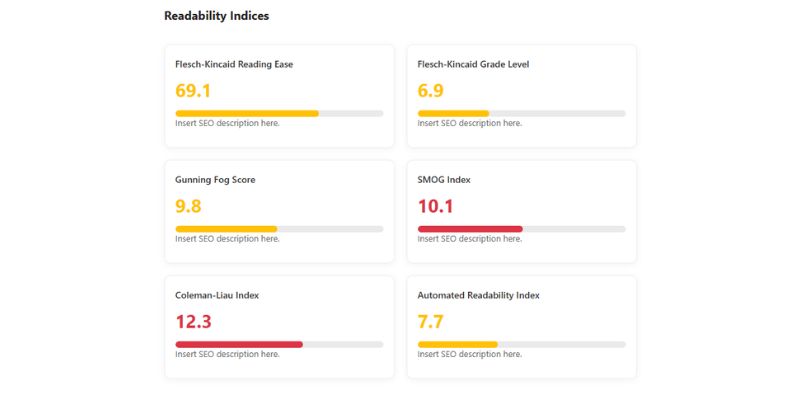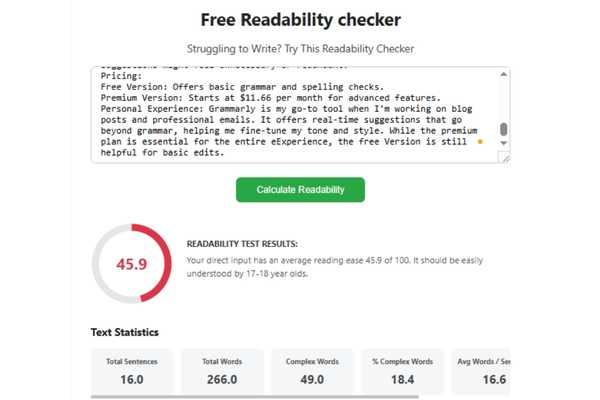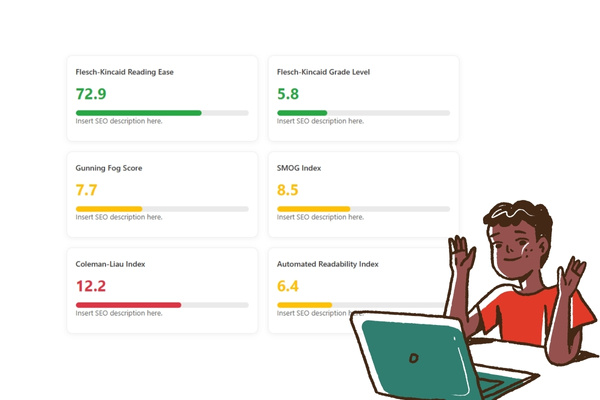Free Readability Test Tool
Readability Test:Have you written something you thought was amazing only to have it scanned or, worse, ignored completely? Yeah, me too. I once poured my heart into a blog post, only to find out it read like a legal document. Clarity wasn’t just a nice-to-have, I realized then. That was the main idea.
However, writing clarity refers to how easily your content is understood. And trust me, even good ideas can flop if they’re wrapped in confusing language. Whether you’re crafting blog posts, sending emails, or writing product descriptions, making sure your content is clear helps you hold attention longer and connect better.
Paste Your Text and Cheak your Article Readability
Free Readability checker
Struggling to Write? Try This Readability Checker
READABILITY TEST RESULTS:
Text Statistics
Readability Indices
Higher is better. Scores above 60 are good; 70+ is very easy to read.
Shows U.S. grade level. Lower 8 scores mean easier-to-read content.
Lower is better. A score under 8 is clear for general audiences.
Counts complex words. A score below 8 suits health, legal, and educational readers best.
Based on letters and sentence length. Under 10 = clear and easy to read.
Lower is better. Scores under 10 indicate middle school readability.
So, What’s a Readability Tool Anyway?

I used to think that smarter writing meant longer words and complex sentences. Turns out, the opposite is true. Simpler is often better. Google knows this, too. It favors content that's easy to read—because users do.
I've written pieces before that were technically sound, but they didn't land with readers. After testing them through a checker, I realized I was over-complicating things. Once I simplified my structure and vocabulary, engagement went up.
The Scoring Systems You Should Know

There are several systems out there, and while they all sound a bit nerdy, they've helped me understand where I go wrong. Here are the ones I use most usually:
- Flesch Reading Ease : 0–100 scale; higher is better. Aim for 70–80 for general readers.
- Flesch-Kincaid Grade Level : Suggests U.S. grade level. Try to keep it around 8–9.
- Gunning Fog Index : Indicates years of education required to understand. Ideal: 7–8.
- Coleman-Liau Index : Based on characters instead of syllables. Useful for academic writing.
- SMOG Index : Focuses on polysyllabic words. Less = clearer writing.
- Automated Readability Index (ARI) : Fast, efficient, and gives a grade estimate. Used in education & tech fields.
Each of these gives you a various grade. I usually run my drafts through two or three to get a balanced picture.
Try it yourself: simplify, test, improve—and watch engagement grow!
Common Questions I Hear (and Ask Myself)
What's a good clarity score? ▶
Which scoring system is most accurate? ▶
Can I improve without a tool? ▶
Does this stuff affect SEO? ▶
Is there a way to check content for free? ▶
Final Thoughts: Writing Is About Being Understood ▶
So, if you've been writing your heart out and still getting crickets, it might not be your message—it might just be the way it's presented. Give a clarity checker a shot and see what you uncover.

